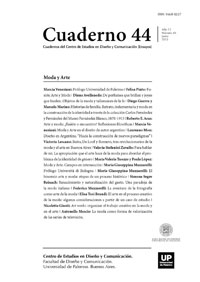Historias de familia. Retrato, indumentaria y moda en la construcción de la identidad a través de la colección Carlos Fernández y Fernández del Museo Fernández Blanco, 1870-1915
Abstract
: In 2010, the Spanish American Art Museum Isaac Fernández Blanco received a
donation from the sisters Fernandez and Fernandez consisting in a lot of wedding dresses and
suits brought together by their grandmother Dominga Nicola from 1870 –date of his own
wedding– and 1930, along with a hundred family photos gathered in two albums, and the
book where Dominga or her daughter scored the marriages of the family in those years. Image,
clothing, and word is articulated in a singular story of rituals and socialization practices of a
middle-class immigrant family in that Buenos Aires at the turn of the century, but also a series
of practices, historically registered, construction and organization of individual identities and
gender roles and their inclusion in the social and cultural network of an era. From the research
task involving the display and appreciation of this heritage, this article analyzes the role of fashion, clothing and portrait photography in the construction of such representations.
References
AAVV (2010, enero-abril). Alquimia. Sistema Nacional de Fototecas, 13 (38), 25.
Barón Friedrichsthal. (1841, abril). El daguerrotipo. El museo yucateco, 4.
Barthes, R. (1986). Lo obvio y lo obtuso. Imágenes, gestos, voces. Buenos Aires: Paidós.
Cuarterolo, M. (1995). Las primeras fotografías del país. En Adelman, J. y Cuarterolo, M. (Eds.)
Los años del daguerrotipo. Primeras fotografías argentinas 1843-1870. Buenos Aires: Fundación Antorchas.
Crane, D. (2000). Fashion and Its Social Agendas: Class, Gender, and Identity in Clothing. Chicago: University of Chicago Press.
De la Canal, J. A. (1944, septiembre). Daguerrotipos Porteños. Atlántida-Ilustración Argentina. Buenos Aires: Atlántida.
De Larra, M. J. (1857). El álbum (1835). En Obras completas de Fígaro (Don Mariano José de Larra) – Tomo 1. París: Baudry.
Dubois, P. (1986). El acto fotográfico. De la Representación a la Recepción. Buenos Aires: Paidós.
Entwistle, J. (2002). El cuerpo y la moda. Una visión sociológica. Barcelona: Paidós, 173-249.
Facio, S. y D’Amico, A. (1988). La fotografía 1840-1930. En AAVV Historia General del Arte en la Argentina – Tomo V. Buenos Aires: Academia Nacional de Bellas Artes.
Flaubert, G. (1999). Madame Bovary. Madrid: EDAF.
Frič, P. y Fričova, I. (2012). Guido Boggiani, fotógrafo. En AAVV. Boggiani y el Chaco: Una aventura del siglo XIX. Fotografias de la Coleccion Frič. Buenos Aires: Museo de Arte Hispanoamericano Isaac Fernández Blanco y Museo Pueyrredón.
Gómez, J. (1986). La fotografía en la Argentina. Su historia y evolución en el siglo XIX. 1840-1899. Buenos Aires: Abadía.
Guerra, D. (2010). Con la muerte en el álbum: la fotografía de difuntos en Buenos Aires durante la segunda mitad del siglo XIX. TRACE - Travaux et Recherches dans les Amériques du Centre (58), 103-112.
(2009). A pesar de que la mía es historia… Naturalismo e imaginarios fotográficos en la literatura argentina del ochenta. En AAVV Balances, perspectivas y renovaciones disciplinares de la historia del arte. V Congreso Internacional de Teoría e Historia del Arte. Buenos Aires: CAIA.
Hart, A. (2005). Fan. En Steele, V. (Ed.). Encyclopedia of Clothing and Fashion. Volume 2. New York/London: Gale, 5.
Hart, A. y Taylor, E. (1980). Fans. London: Christies/Studio Vista.
Harvey, J. (1995). Men in Black. London: Reaktion Books.
Hollander, A. (1994). Sex and Suits. The Evolution of Modern Dress. London: Kodansha Globe.
Lemagny, J-C. y Rouillé, A. (Eds.) (1988). Historia de la fotografía. Barcelona: Martínez Roca.
Mangel de Mesnil, É. (1855, agosto 15). Gran establecimiento de fotografía, de La Fama de los Retratos. La Revolución, I (13).
Marbot, B. (1988). Los primeros pasos de la nueva imagen (1839-1850). En Lemagny, J-C. y
Rouillé, A. (Eds.) (1988) Historia de la fotografía. Barcelona: Martínez Roca.
Marino, M. (2010). Abanicos. En Amigo, R. (comp.) Museo Nacional de Bellas Artes. Colección. Antigüedad/1919: parte 2, 217. Buenos Aires: Arte Gráfico Editorial Argentino.
Newhall, B. (2002). Historia de la fotografía. Barcelona: Gustavo Gili.
Palmer, A. (2008). Untouchable: Creating Desire and Knowledge in Museum Costume and Textile Exhibitions. Fashion Theory, XII (1), 31-64.
Revell DeLong, M. (2005). Theories of Fashion. En Steele, V. (Ed.) Encyclopedia of Clothing and Fashion. Volume 2. New York/London: Gale, 21-26.
Roche, D. (1989). La culture des apparences. Une histoire du vêtement XVIIe-XVIIIe siècle. Paris: Fayard.
Sekula, A. (2003). El cuerpo y el archivo. En Picazo, G. y Ribalta, J. (Eds.) Indiferencia y singularidad. Barcelona: Gustavo Gili.
Steele, V. (1996). Fetish. Fashion, Sex & Power. New York: Oxford University Press.
(2002). The Fan: Fashion and Femininity Unfolded. New York: Rizzoli.
(2007). The Black Dress. New York: Harper Collins.
Tagg, J. (2003). La carga de la representación. Ensayos sobre fotografías e historias. Barcelona: Gustavo Gili.
Taylor, L. (2005). Historical Studies of Fashion. En: Steele, V. (Ed.). Encyclopedia of Clothing and Fashion. Volume 2. New York/London: Gale, 16-21.
Los autores/as que publiquen en esta revista ceden los derechos de autor y de publicación a "Cuadernos del Centro de Estudios de Diseño y Comunicación", Aceptando el registro de su trabajo bajo una licencia de atribución de Creative Commons, que permite a terceros utilizar lo publicado siempre que de el crédito pertinente a los autores y a esta revista.


